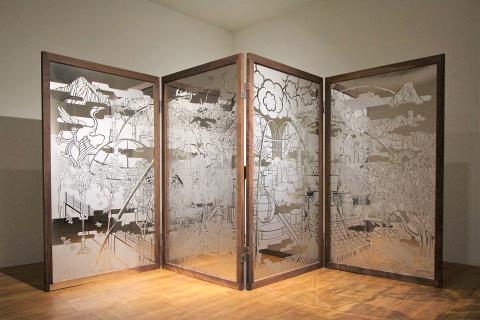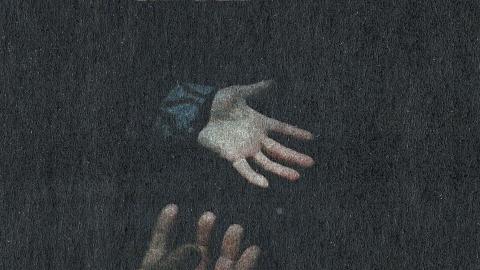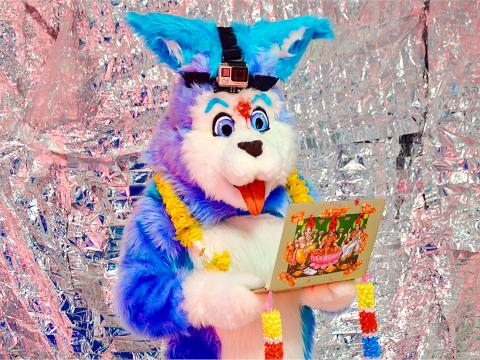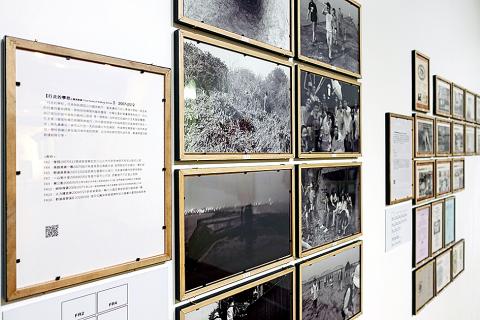Organized by the Museum of Contemporary Art Taipei (台北當代藝術館, MOCA, Taipei), Once Upon A Time (少年當代─未終結的過去進行式) is a cross-generational exhibition about contemporary art from a humanitarian perspective. The exhibition asks: What kind of life stories, daily events, environments or attitudes have contributed to individual art practices and artistic ways of thinking? The show highlights coming-of-age experiences and their historical context — how social and political climates have affected individual processes of becoming. Leo Liu (劉秋兒) is an artist and activist concerned with labor issues. His archival work, Is Resistance Beautiful?, is a series of photographs and documents about social issues and his action-based art practice, examining aesthetics in relation to activism and performance. Shuy Ruey-Shiann (徐瑞憲) is a Taipei-born artist who creates kinetic sculptures and installations about human life and the environment through the perspective of a machine. Nine Dreams — Hopscotch (九個夢—跳格子) is an installation that contains imaginative clues about the future.
■ Museum of Contemporary Art (台北當代藝術館, MOCA, Taipei), 39, Changan W Rd, Taipei City (台北市長安西路39號), tel: (02) 2559-6615. Open Tuesdays to Sundays from 10am to 6pm
■ Until Oct. 13

Photo Courtesy of Powen Gallery
The Middleman, The Backpacker, The Alien Species, and The Time Traveler (留洋四鏢客) is a group show at TKG+ Projects that explores the trajectory of globalization through the four characters mentioned in the title. A particular kind of middleman in Asia known as the Dan Bang Ke (單幫客) came to rise in the early 20th century, a time marked by burgeoning signs of globalization. The Dan Bang Ke were loners who traveled abroad and returned with foreign merchandise for sale — clothes, medicine, cosmetics and so on. This led to the opening of shops for imported goods during the 70s and 80s. After the Cold War, according to the exhibition text, backpackers replaced the Dan Bang Ke as globetrotters who continued to wander the world while fostering a distinct culture of co-observation and participation. The show also considers the perspective of an alien species as well as a time traveler who embodies fictional movements throughout time and space.
■ TKG+ Projects, B1, 15, Ln 548, Ruiguang Rd, Taipei City (台北市瑞光路548巷15號B1), tel: (02) 2659-0798. Open Tuesdays to Sundays from 11am to 7pm
■ Until Sept. 8

Photo courtesy of National Taiwan Museum of Fine Arts
Luo He-lin (羅禾淋) is a Taipei-based artist who works at the intersection of technology and cross-disciplinary art. His experience as a gamer informs his explorations of virtual reality and Internet migration. If This is a Global Surveillance Center (如果這是全球監控中心) relates to the rising power of global surveillance in today’s age of the cloud computing. In three parts, it proposes ways of reversing this trend: a method of exposing the IP location of surveillance cameras; the physical location of the cameras and services; and directing the surveillance system to a staged presentation of a text, titled: “A Declaration of the Independence of Cyberspace” by American writer and activity John Perry Barlow.
■ National Taiwan Museum of Fine Arts (國立台灣美術館), 2, Wuquan W Rd Sec 1, Taichung City (台中市五權西路一段2號), tel: (04) 2373-3552. Open Tuesdays to Fridays from 9am to 5pm, Saturdays and Sundays from 9am to 6pm
■ Until Sept. 22

Photo courtesy of TKG+ Projects
Wu Chia-yun (吳家昀) is a Taiwanese artist with a background in visual communication and film studies. She creates narrative films, videos and moving image installations that address the nature of film and the human condition. Her works are often poetic and experimental, and travel the boundaries between narrative and non-narrative frameworks. Wu is keen on observing life from a philosophical point of view through multimedia works. Her solo exhibition, Darkness Within Darkness (空), is a digital film translated into a physical format of 24 frames per second. The film reel is then manipulated through scanning and printing different paper textures. Wu’s interest in this process lies in the physicality of the film reel and the formlessness of the original digital file.
■ National Taiwan Museum of Fine Arts (國立台灣美術館), 2, Wuquan W Rd Sec 1, Taichung City (台中市五權西路一段2號), tel: (04) 2373-3552. Open Tuesdays to Fridays from 9am to 5pm, Saturdays and Sundays from 9am to 6pm
■ Until Sept. 29

Photo Courtesy of MOCA Taipei
Currently on view at Powen Gallery (紅野畫廊) is a solo exhibition by Chen Han-sheng (陳漢聲). Chen is a multidisciplinary artist born into a family of farmers. Seeking to find a connection between their life and his own, his projects have explored agricultural and artistic labor practices, which he does in After the Explosion (牆隔神農), an exhibition that explores the relationship between the petrochemical industry in Kaohsiung and its negative environmental effects on farming.
■ Powen Gallery (紅野畫廊), 11, Ln 164, Songjiang Rd, Taipei (臺北市松江路164巷11號), tel: (02) 2523-6009. Open Tuesdays to Sundays from 10am to 7pm.
■ Until Aug. 18

On April 26, The Lancet published a letter from two doctors at Taichung-based China Medical University Hospital (CMUH) warning that “Taiwan’s Health Care System is on the Brink of Collapse.” The authors said that “Years of policy inaction and mismanagement of resources have led to the National Health Insurance system operating under unsustainable conditions.” The pushback was immediate. Errors in the paper were quickly identified and publicized, to discredit the authors (the hospital apologized). CNA reported that CMUH said the letter described Taiwan in 2021 as having 62 nurses per 10,000 people, when the correct number was 78 nurses per 10,000

As Donald Trump’s executive order in March led to the shuttering of Voice of America (VOA) — the global broadcaster whose roots date back to the fight against Nazi propaganda — he quickly attracted support from figures not used to aligning themselves with any US administration. Trump had ordered the US Agency for Global Media, the federal agency that funds VOA and other groups promoting independent journalism overseas, to be “eliminated to the maximum extent consistent with applicable law.” The decision suddenly halted programming in 49 languages to more than 425 million people. In Moscow, Margarita Simonyan, the hardline editor-in-chief of the

Six weeks before I embarked on a research mission in Kyoto, I was sitting alone at a bar counter in Melbourne. Next to me, a woman was bragging loudly to a friend: She, too, was heading to Kyoto, I quickly discerned. Except her trip was in four months. And she’d just pulled an all-nighter booking restaurant reservations. As I snooped on the conversation, I broke out in a sweat, panicking because I’d yet to secure a single table. Then I remembered: Eating well in Japan is absolutely not something to lose sleep over. It’s true that the best-known institutions book up faster

Though the total area of Penghu isn’t that large, exploring all of it — including its numerous outlying islands — could easily take a couple of weeks. The most remote township accessible by road from Magong City (馬公市) is Siyu (西嶼鄉), and this place alone deserves at least two days to fully appreciate. Whether it’s beaches, architecture, museums, snacks, sunrises or sunsets that attract you, Siyu has something for everyone. Though only 5km from Magong by sea, no ferry service currently exists and it must be reached by a long circuitous route around the main island of Penghu, with the